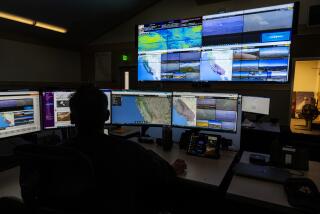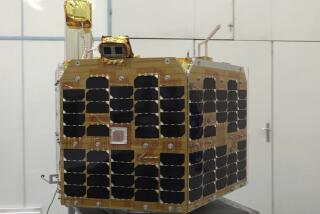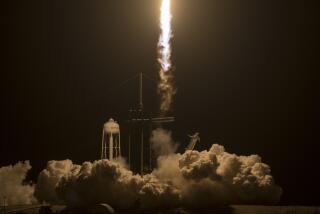NASA launches Earth-observing satellite on third try
Amid growing concern about global weather patterns, a rocket roared into space Saturday carrying a NASA satellite that will give scientists new tools to forecast weather, track drought and monitor climate change.
The liftoff from Vandenberg Air Force Base in Southern California was the third attempt to launch the craft. Upper-level wind shear above the base near Lompoc had already prompted NASA to push Thursday morning’s launch to Friday.
The second postponement came after inspections revealed problems with the booster insulation of the United Launch Alliance Delta II rocket, according to the agency.
Once fully deployed, the 2,000-pound craft will aim two microwave-emitting instruments at the Earth’s surface and collect data that will enable the agency to determine the moisture content of the top two inches of soil planetwide and to calculate water depth to about three feet, said Jared Entin, NASA’s Washington-based project scientist for the Soil Moisture Active Passive (SMAP) mission.
The radiometer and radar will work in tandem to pick up subtle changes in a narrow spectrum of microwave radiation known as the L-band, as the microwaves scatter and reflect from the Earth’s surface, said Entin.
“What we’re measuring is the dip in the energy coming back from Earth in this spectrum,” Entin said. “The more the dip, the more water is blocking the signal.”
The content of water in soil, and by extension in plants and crops, has been a somewhat opaque factor in forecast and climate models. Scientists have mainly relied on a relatively sparse array of ground instruments.
From an altitude of about 426 miles, the satellite will be able to sweep all of the Earth’s surface, regardless of cloud cover, in two to three days, offering a resolution of about five or six miles.
Scientists worked for several years to integrate the two instruments into a best-of-both-worlds view of the Earth’s surface. One detects a highly accurate signal but with much lower resolution, while the other can home in on smaller patches, but produce a much “noisier” signal, Entin said.
Although it will take more than a year to gather, calibrate, verify and analyze the information in a way that is suitable for scientific research, NASA plans to release early data sets within several months to forecasters and planners in such agencies as the United Nations World Food Program, U.S. Department of Agriculture and U.S. Centers for Disease Control and Prevention.
Eventually, such information will help predict floods, drought, famine, crop yields, weather and climate change.
“This water in the soil is a cog between three important cycles in the Earth system -- the water cycle, the carbon cycle and the energy cycle,” Entin said.
Researchers will be able to fill in many details about the solar energy involved in evaporation and movement of water in the atmosphere, and about how plants absorb carbon dioxide.
Climate models agree that the Earth is warming, but they differ about such fundamental issues as which areas will get more precipitation and which will be drier, Entin said.
“Certainly the people in California would like to know: Are we the area that’s getting drier, or might we be getting wetter?” he said.
But there will be more pragmatic, and profound, applications for the data. Water managers will be able to make decisions about irrigation and drinking water supply, meteorologists will use the data to refine their short- and long-range predictions, and health officials may be better able to predict mosquito-borne infection, he said.
The $916-million mission was engineered to work for at least five years, although many NASA satellites have endured for far longer, Entin noted.
“If the satellite works on Day 1, odds are it will work for a decade or longer,” Entin said.
Twitter: @LATsciguy







